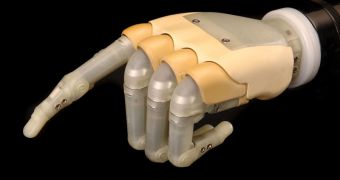A new prototype bionic hand is now being tested on several people and could eventually be used to replace lost limbs for US soldiers who suffered injuries in the Iraq war. The new prosthesis is an artificial extension than could go almost unnoticed due to its strong resemblance to the human hand.
The resemblance goes far beyond the exterior aspect, although this is important as well and has more to do with the natural way in which the fingers of the bionic hand move, grip and are controlled by the patient's mind and muscles.
Invented by David Gow, from the National Health Service of Scotland (NHS) and constructed by Touch Bionics, based in Livingston, the new prototype "is the first hand to come to the market that's actually had bending fingers just like your own hand," as Gow declared for BBC.
It's the first fully integrated prosthetic hand that can be controlled naturally and provides a level of control far beyond the current state-of-the-art for prosthetic applications.
"The hand does feel like a replacement for my missing hand and it is now very natural for me to pick up all sorts of objects. It makes everyday activities much easier," explained Donald MacKillop, a retired welder who lost his right hand in a work accident 30 years ago and, since 2006, has been fitted with the new bionic hand for testing purposes.
"If you gave someone this hand for a month and then gave them back their old device, they would be very disappointed."
The i-LIMB Hand is much easier to control, especially in the most sensitive areas, like the exact pressure that must be applied to pick up a glass or a raw egg without crushing it or dropping it, a delicate balance achieved using individual motors for each digit and the ability to perform complex movements and operations.
As Touch Bionic advertises in a drawing of the arm, "sensors in socket pick up myoelectric signals from muscles to make full range of movements," making the bionic prosthesis "a generational advance in bionics and patient care."

 14 DAY TRIAL //
14 DAY TRIAL //